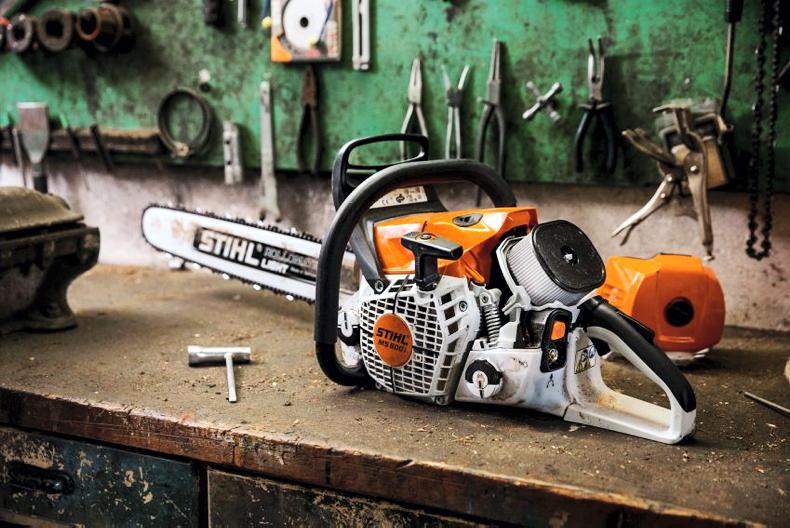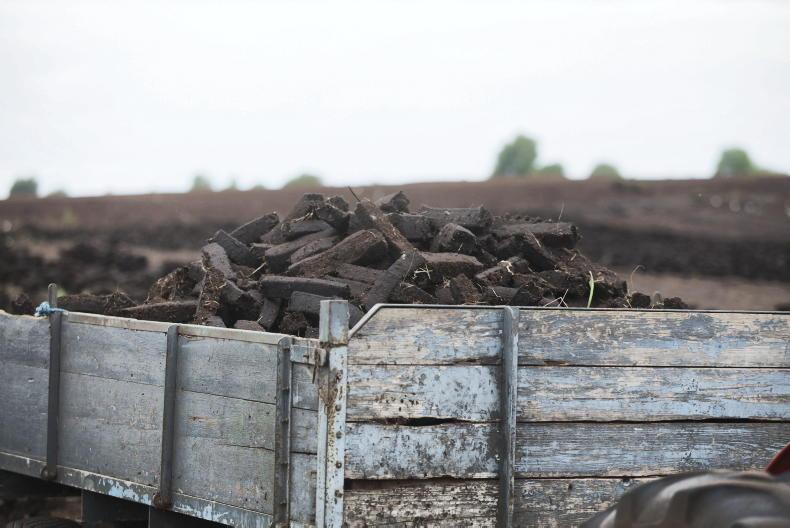The popularity of telehandlers and articulated wheel loaders on Irish farms is ever increasing. This was very obvious with the large range on display at the recent National Ploughing Championships. Telehandlers are extremely versatile machines and are used by farmers for a huge range of various tasks throughout the year.
As with any used machine, the challenge is to locate one that has been regularly serviced and greased.
We take a look at a 2012 JCB TM 310S which would be a popular machine used by many farmers throughout the country. This particular machine had 5,000 hours on the odometer, averaging in excess of 700 hours per year.
First glance
A first glance at the general condition of a machine will tell you a lot about how it has been treated. The fiberglass bonnet (€4,000 plus VAT) and mudguards are very expensive to replace and potential buyers should take this into account.
Lights, mirrors and all glass in the cab should be functional and intact. The machine should be started and let run for five to 10 minutes before bringing it for a drive.
Wear and tear
As with any machine, regular service intervals and the consistent greasing will determine its lifespan. The main points of wear and tear to watch out for in the JCB telehandler are the central pivot point, steering rams, pins and bushings. These machines can be very costly to re-bush so potential buyers must take this into consideration.
The central pivot point is constantly in action and its life expectancy is very much dependant on how regular it is greased. A new central pivot pin, two bushings and the bearings to coincide would set you back €950 plus VAT.

A potential buyer should see if the boom frame edges closer to the windscreen when downward pressure is applied on the implement against the ground.
A potential buyer should watch out to see if the boom frame (pictured) edges closer to the windscreen when downward pressure is applied on the implement against the ground. If so, this is an indication of significant wear and you should approach cautiously.
The wear and tear of the pins and bushings in a machine can help tell you if it was greased on a regular basis or if the hours on the odometer are genuine.
Tyre condition will have a bearing on the valuation of the machine and will give a potential buyer a good indication of hours the machine has clocked up.
A headstock that has not received adequate grease will have worn significantly. A new headstock will cost in the region of €3,000 plus VAT.
The boom should be extended and inspected for any cracks or bends. Ideally, there should also be grease on the walls. A screeching nose when extending the boom will indicate a lack of grease.
Engine
The engine should be clean and dry. The potential buyer should enquire about service intervals and check the oil by pulling the dipstick. Ideally, the oil should have a good viscosity and be fresh. Gloopy, stringy oil will indicate that the machine has gone past its required service interval.
The breather pipe on the underbody of the machine should be free of dripping oil or smoke. If smoke is coming out of the breather pipe, it may indicate head gasket issues.
The radiator should be inspected for damage. Coolant should be sitting at the recommended level and not leaking. The air filter should be checked to see if it is full of dust, again indicating how well the machine was looked after. A blocked air breather will put a serious strain on both the turbo and the engine.

The engine should be clean and dry and the interested party should check the viscosity of the oil.
Transmission and brakes
The handiest way to check the six-speed power-shift transmission is to drive the machine forward and in reverse in each gear which it should do so at its ease.
Depending on how many hours the machine has clocked up and the work it has carried out, the brakes may need to be done. The brakes should react to force being applied to the brake pedal. It is essential that the brakes are responsive. If not, this poses a serious safety hazard and will leave the buyer with a costly repair bill. Axle hubs should be checked for any leakages.
Hydraulics
The easiest way to check the hydraulics is to test all functions and ensure they are responsive at the same time. The boom should be extended while lifting and tilting it at the same time.
These functions should all work comfortably together.
All hydraulic hoses should be inspected to ensure there are no leaks or perished hoses. Similarly, the seals should be checked for leaks on each ram. If an internal seal is damaged it can be a costly job to replace and will leave the machine out of action for a period of time.
An overdue hydraulic oil and filter service interval will slow the hydraulic system and will give you an indication of how well the machine was cared for. There is a sight glass on the back left corner of the machine where you can check the hydraulic oil level.

The seals should be checked for leaks on each ram. If an internal seal is damaged it can be a costly job to repair.
Load monitor indicator
It is vital that the load monitor indicator (LMI) is working. This is a safety device that is present in all telehandlers. It constantly analyses load pressure via a sensor in the back axle and prevents the operator over exerting the boom with a heavy weight.
What is this machine worth?
It must be noted that these machines can vary significantly in price depending on the machine’s condition, tyre condition and hours the machine has clocked up. For a 2012 JCB TM310s, farmers can expect to pay anywhere from €40,000 to €50,000 plus VAT.
Checking the cab
Similar to the general exterior condition the interior condition of the cab can give a good indication of how well the machine was looked after. Starting with the handbrake, for obvious health and safety reasons it is important that it’s fully functional.
Generally, an issue with the handbrake is as simple as replacing the cable.
If the machine is fitted with an air seat, it should be checked to see if it’s working. A new air seat would be expensive.
All functions on the joystick should be tested. Many telehandlers will have functions such as forward/reverse, third hydraulic service, boom out/in, hydraulic quick-hitch and general movement of the boom on the joystick.
All switches should be inspected including boom suspension, lights and air con/heater.
The dash should be checked to ensure there are no warning lights being signalled. The temperature gauge should be monitored and unless being worked very hard, it should not pass the half way mark.
The torque lock switch should be tested to ensure that it is functional. Its function is to keep power to the wheels while working on an incline such as a hill or on a pit of silage.
Machine specs
Engine: JCB Dieselmax 4.4-litre, four-cylinder engine producing 145hp.Transmission: six-speed 40km/h power-shift transmission with TorqueLock. Hydraulics: maximum flow on demand to 140 litres/min.Max lift height: 5.2m.Max lift capacity: 3,100kg.Fuel tank capacity: 160 litres.Unladen weight: 8,000kg.List price (when new): €83,000 plus VAT (not being manufactured anymore).
The popularity of telehandlers and articulated wheel loaders on Irish farms is ever increasing. This was very obvious with the large range on display at the recent National Ploughing Championships. Telehandlers are extremely versatile machines and are used by farmers for a huge range of various tasks throughout the year.
As with any used machine, the challenge is to locate one that has been regularly serviced and greased.
We take a look at a 2012 JCB TM 310S which would be a popular machine used by many farmers throughout the country. This particular machine had 5,000 hours on the odometer, averaging in excess of 700 hours per year.
First glance
A first glance at the general condition of a machine will tell you a lot about how it has been treated. The fiberglass bonnet (€4,000 plus VAT) and mudguards are very expensive to replace and potential buyers should take this into account.
Lights, mirrors and all glass in the cab should be functional and intact. The machine should be started and let run for five to 10 minutes before bringing it for a drive.
Wear and tear
As with any machine, regular service intervals and the consistent greasing will determine its lifespan. The main points of wear and tear to watch out for in the JCB telehandler are the central pivot point, steering rams, pins and bushings. These machines can be very costly to re-bush so potential buyers must take this into consideration.
The central pivot point is constantly in action and its life expectancy is very much dependant on how regular it is greased. A new central pivot pin, two bushings and the bearings to coincide would set you back €950 plus VAT.

A potential buyer should see if the boom frame edges closer to the windscreen when downward pressure is applied on the implement against the ground.
A potential buyer should watch out to see if the boom frame (pictured) edges closer to the windscreen when downward pressure is applied on the implement against the ground. If so, this is an indication of significant wear and you should approach cautiously.
The wear and tear of the pins and bushings in a machine can help tell you if it was greased on a regular basis or if the hours on the odometer are genuine.
Tyre condition will have a bearing on the valuation of the machine and will give a potential buyer a good indication of hours the machine has clocked up.
A headstock that has not received adequate grease will have worn significantly. A new headstock will cost in the region of €3,000 plus VAT.
The boom should be extended and inspected for any cracks or bends. Ideally, there should also be grease on the walls. A screeching nose when extending the boom will indicate a lack of grease.
Engine
The engine should be clean and dry. The potential buyer should enquire about service intervals and check the oil by pulling the dipstick. Ideally, the oil should have a good viscosity and be fresh. Gloopy, stringy oil will indicate that the machine has gone past its required service interval.
The breather pipe on the underbody of the machine should be free of dripping oil or smoke. If smoke is coming out of the breather pipe, it may indicate head gasket issues.
The radiator should be inspected for damage. Coolant should be sitting at the recommended level and not leaking. The air filter should be checked to see if it is full of dust, again indicating how well the machine was looked after. A blocked air breather will put a serious strain on both the turbo and the engine.

The engine should be clean and dry and the interested party should check the viscosity of the oil.
Transmission and brakes
The handiest way to check the six-speed power-shift transmission is to drive the machine forward and in reverse in each gear which it should do so at its ease.
Depending on how many hours the machine has clocked up and the work it has carried out, the brakes may need to be done. The brakes should react to force being applied to the brake pedal. It is essential that the brakes are responsive. If not, this poses a serious safety hazard and will leave the buyer with a costly repair bill. Axle hubs should be checked for any leakages.
Hydraulics
The easiest way to check the hydraulics is to test all functions and ensure they are responsive at the same time. The boom should be extended while lifting and tilting it at the same time.
These functions should all work comfortably together.
All hydraulic hoses should be inspected to ensure there are no leaks or perished hoses. Similarly, the seals should be checked for leaks on each ram. If an internal seal is damaged it can be a costly job to replace and will leave the machine out of action for a period of time.
An overdue hydraulic oil and filter service interval will slow the hydraulic system and will give you an indication of how well the machine was cared for. There is a sight glass on the back left corner of the machine where you can check the hydraulic oil level.

The seals should be checked for leaks on each ram. If an internal seal is damaged it can be a costly job to repair.
Load monitor indicator
It is vital that the load monitor indicator (LMI) is working. This is a safety device that is present in all telehandlers. It constantly analyses load pressure via a sensor in the back axle and prevents the operator over exerting the boom with a heavy weight.
What is this machine worth?
It must be noted that these machines can vary significantly in price depending on the machine’s condition, tyre condition and hours the machine has clocked up. For a 2012 JCB TM310s, farmers can expect to pay anywhere from €40,000 to €50,000 plus VAT.
Checking the cab
Similar to the general exterior condition the interior condition of the cab can give a good indication of how well the machine was looked after. Starting with the handbrake, for obvious health and safety reasons it is important that it’s fully functional.
Generally, an issue with the handbrake is as simple as replacing the cable.
If the machine is fitted with an air seat, it should be checked to see if it’s working. A new air seat would be expensive.
All functions on the joystick should be tested. Many telehandlers will have functions such as forward/reverse, third hydraulic service, boom out/in, hydraulic quick-hitch and general movement of the boom on the joystick.
All switches should be inspected including boom suspension, lights and air con/heater.
The dash should be checked to ensure there are no warning lights being signalled. The temperature gauge should be monitored and unless being worked very hard, it should not pass the half way mark.
The torque lock switch should be tested to ensure that it is functional. Its function is to keep power to the wheels while working on an incline such as a hill or on a pit of silage.
Machine specs
Engine: JCB Dieselmax 4.4-litre, four-cylinder engine producing 145hp.Transmission: six-speed 40km/h power-shift transmission with TorqueLock. Hydraulics: maximum flow on demand to 140 litres/min.Max lift height: 5.2m.Max lift capacity: 3,100kg.Fuel tank capacity: 160 litres.Unladen weight: 8,000kg.List price (when new): €83,000 plus VAT (not being manufactured anymore). 











SHARING OPTIONS